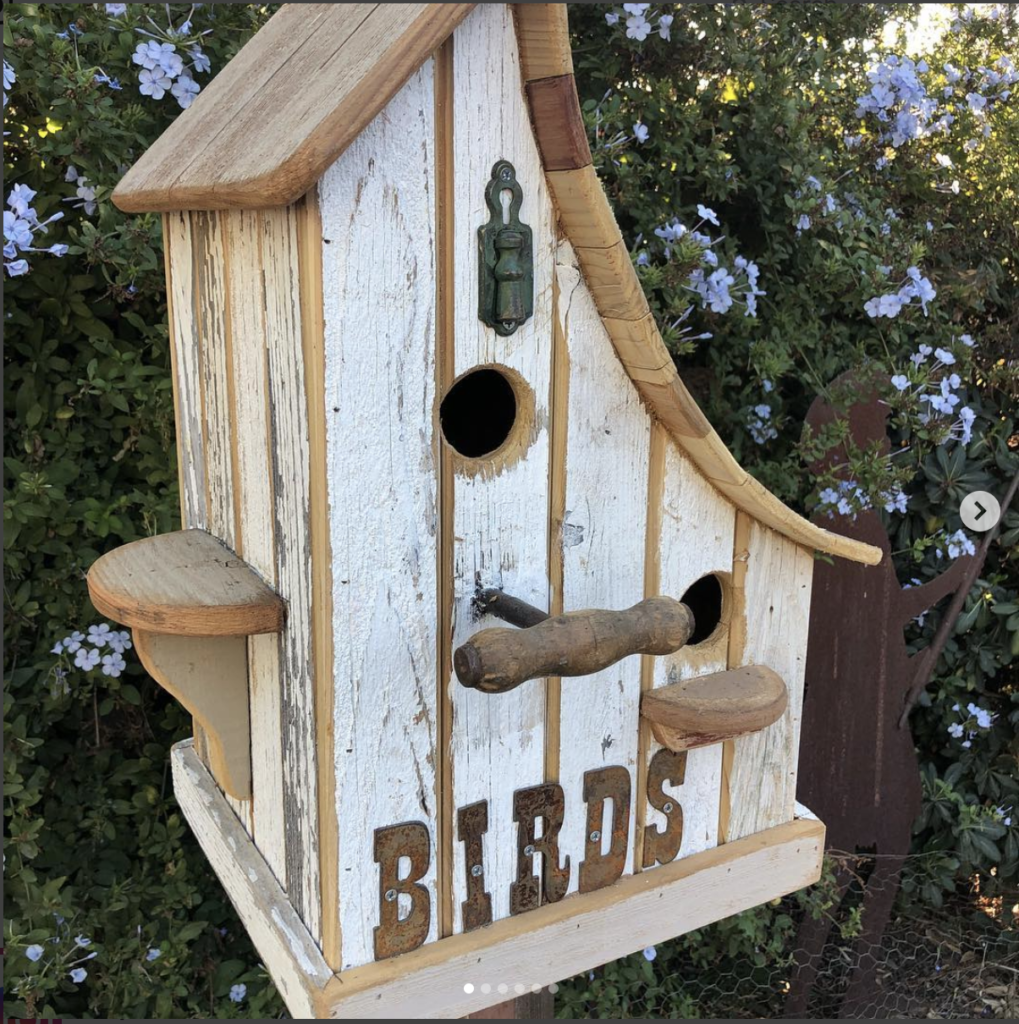
Years ago, when the children were growing up, there was a simple birdhouse hanging on an old oak tree outside my bedroom window amid small banana trees and a profusion of ferns. It was a wooden structure made of raw plywood with a sloping roof, a small hole in the front, no frills. But no birds came. And

But for a couple of years the birdhouse in the oak tree was the exclusive domain of a tree frog. He would hang on the wall inside with his head sticking out of the hole waiting for the morning bug traffic. Around the property were a number of other similar birdhouses, none occupied by birds, most by bugs.
They were the remains of a small business I started enthusiastically with the kids. We called it Berger Bros. Better Built Birdhouses. Be a Birdie’s Buddy and Buy a Birdhouse. Practice on the Birds and then Love Your Neighbors. With these encouraging slogans we began a buildin’. Half inch plywood scraps from a construction site provided most of the material. We cut them in four, five and six inch strips with the table saw and then made cardboard templates for the sides, front, top and bottom. We cut triangles off the corners of the bottom pieces for drainage, cut a hole in the front piece for the birds to get in, put a small hole in the back piece to hang them, and sloped the roof slightly and made it overlap the front. We nailed the pieces together with small finishing nails except for one side piece which we hinged by nailing it only once at the top, securing the bottom with a screw so we could get inside and clean it out. The sides were shorter than the front and back, giving ventilation at the top.

The best part was coloring them. We didn’t want to use paint for the bird’s sake. So I found an old plumber’s blow torch in one of the sheds, filled it with gas and fired it up. Its frightful whooshing had everyone standing at a safe distance. A couple of quick passes on each side of the birdhouse burnt the soft grain of the plywood. Then we brushed it with a stiff brush. The result was a rustic, black and brown, unfinished surface that blended well with the tree bark. We went around the property and hung a few of them on trees, fully expecting birds to move in. The rest went on nails on the side of the workshop. The unfinished strips of wood were neatly stacked under the workbench and the templates, made out of cardboard, were tucked away into manila folders for later production.
What followed next was an encouraging series of lectures from the founder. “The Goodness of Productivity” and “Finding Time For The Less Fortunate” became suppertime subjects. Somehow I imagined birds were homeless without our birdhouses.

Too soon, autumn returned, the kids went back to school and all my idealism was swallowed up by reality. Work began demanding more and more of my time. And the kids, being busy with schoolwork and new friends didn’t return to the project on their own; it went the way of lost enthusiasm. If birds had moved into the existing birdhouses, I might have been able to revive interest on the weekends.
The next spring I made an interesting discovery. I was rummaging around in the library and the idea of resurrecting the birdhouse business struck me. Summer was coming and the kids would soon be out of school and needed constructive projects. Perhaps more ornate designs would spark enough interest to revive the birdhouse business. I gathered up a small stack of books on building birdhouses, took a comfortable chair, and began to read.

The results were illuminating. I discovered that birdhouse design is more important than I had thought it was. I was pleased to learn that I had done a few things right. The ventilation was necessary. The drainage holes and clean out access were good design. And most of the book’s authors cautioned against using paint. But the birds’ individual needs were more significant than I had imagined. How could I have missed the importance of hole size? Of course, different birds are different sizes, but I just thought a larger hole would accommodate a larger variety of birds. The prospect of littler birds being expatriated by the neighborhood bullies had not occurred to me.
Each birdhouse needs to be designed for a specific bird. The hole has to be just the right size. And the interior space has to be large enough to accommodate the nest and the baby birds to come. Then there’s the distance from the floor to the hole. If the hole is too high, the baby birds won’t be able to hop up to it before their initial flight. I cringed at the vision of going out one day to inspect my birdhouses and finding little baby bird skeletons littering the floors. But the birds instinctively know these needs and that’s why they never inhabited the birdhouses we had built. I had failed to consider the needs of the birds and to do the necessary research.

But how do you define success and failure? I had spent time with my kids and taught them skills along the way even if the project itself had not worked out. And I had learned a lesson I could apply to other areas in my life. My eagerness was enough to get us all motivated but more thought needed to be given to the project before we started building. A quick trip to the library for some research would have provided me with enough information to truly build a better birdhouse. And had the birds moved in, it might have generated enough interest to go on and build more. As it was, we all learned lessons from my mistakes and the kids have had an eye-opening look into the vagaries of their father’s unbridled enthusiasm.
Well, now the kids are grown but there is an accumulation of grandchildren. Recently, I went back to the library to see if I could find anything about frog houses. I wasn’t surprised that there wasn’t a single book on the subject because I am often coming up with wonderful, innovative ideas. Now I’m busily planning my next project. Getting the poor frogs up off the ground will certainly mean less frog and automobile collisions. And the mottoes are coming fast. The Domiciliation of the Common Croaker. Dealing with

-Larry Berger. HashtagWV #108. December 2018
HashtagWV Art & Entertainment is a high-quality print and digital multimedia platform for all things West Virginia and the greater Appalachian region. The editorial focus is local music, unique shopping, the arts, events, theatre, and food and drinks. tiktok.com/@hashtagwv
-
HashtagWVhttps://hashtagwv.com/author/hashtagwv/
-
HashtagWVhttps://hashtagwv.com/author/hashtagwv/
-
HashtagWVhttps://hashtagwv.com/author/hashtagwv/
-
HashtagWVhttps://hashtagwv.com/author/hashtagwv/


